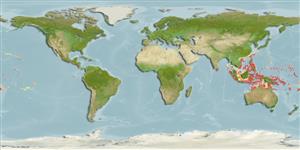Classification / Names
Common names from other countries
Main reference
Size / Weight / Age
Max length : 3.5 cm SL male/unsexed; (Ref. 48637)
Environment
Marine; reef-associated; depth range 8 - 35 m (Ref. 90102)
Climate / Range
Tropical, preferred ?; 30°N - 18°S
Distribution
Western Pacific: Ryukyu and Ogasawara Islands to Rotuma, south to Rowley Shoals in the eastern Indian Ocean and the Great Barrier Reef. Recently recorded from Tonga (Ref. 53797).
Countries | FAO areas | Ecosystems | Occurrences | Introductions
Short description
Dorsal
spines
(total): 7;
Dorsal
soft rays
(total): 9-10;
Anal
spines: 1;
Anal
soft rays: 8 - 9. Has same general appearance as T. caesiura and T. naudei. Characterized by having greyish matrix with dense orange spotting on head and body; presence of faint spotting on fins; elongate second dorsal spine; fifth pelvic ray branched, 60-70% length of fourth ray; longitudinal scale series 26-27; predorsal scales absent; cheek and opercle without scales; depth of body 4.0-4.4 in SL (Ref. 90102).
IUCN Red List Status (Ref. 115185)
Threat to humans
Harmless
Human uses
More information
ReferencesAquacultureAquaculture profileStrainsGeneticsAllele frequenciesHeritabilityDiseasesProcessingMass conversion
Tools
Special reports
Download XML
Internet sources
Estimates of some properties based on models
Phylogenetic diversity index
PD50 = 0.5000 many relatives (e.g. carps) 0.5 - 2.0 few relatives (e.g. lungfishes)
Trophic Level
0
Resilience
High, minimum population doubling time less than 15 months (Preliminary K or Fecundity.)
Vulnerability
Low vulnerability (10 of 100)
Price category
